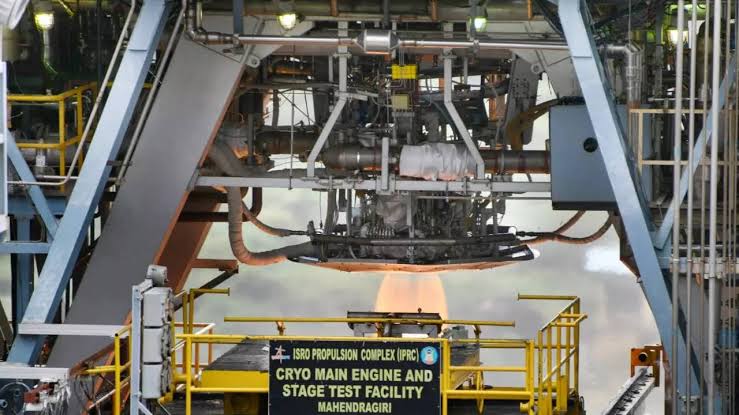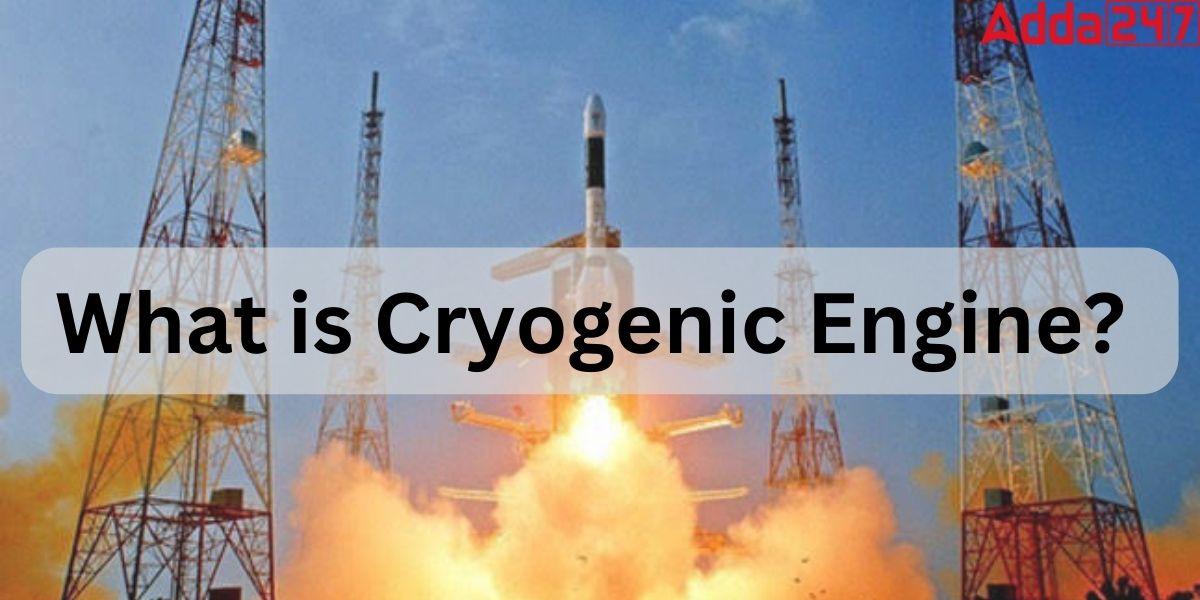Cryogenic Engine: A cryogenic Engine is an engine that uses in space vehicles that utilize cryogenics. The study of how materials behave and are produced at extremely low temperatures (below -150 degrees Celsius) in order to lift and launch heavier objects into space is known as cryogenics.
Recently, The CE20 cryogenic engine, which was built by the Indian Space Research Organization (ISRO) for the LVM3, formerly known as the GSLV-Mk3, has successfully undergone a hot test. In this article we are going to learn about the cryogenic engine, how it works, its fuel, uses, and advantages.
What does Cryogenic Engine Mean?
Cryogenic Engine Meaning: Cryogenic derives from the Greek words “Kyros” (cold or freezing) and “gene” (burn or produced). A cryogenic engine is a rocket engine that uses a cryogenic fuel and oxidizer, meaning that both of these components are liquefied gases that are kept at extremely low temperatures. The process of using rocket propellants at a cryogenic temperature is known as cryogenic technology. Due to the use of propellants at extremely low temperatures, cryogenic rockets are technically a much more complex system than solid or liquid propellant (stored on earth) stages. However, a cryogenic engine is more effective and produces more force per kilogram of cryogenic propellant used than other types of propellants, such as solid and liquid propellant rocket engines.

Cryogenic Engine Inventor
The USA invented the cryogenic engine, which has a long history involving many powerful countries, such as Russia, Japan, France, and others. One of the key components in NASA’s success in using the Saturn V rocket to travel to the Moon was the use of these extremely effective cryogenic engines, which first flew on the US Atlas-Centaur.
Cryogenic Engine India
In the 20th century, the Indian Space Research Organization also experimented with this technology. The Indian Space Research Organisation (ISRO) has successfully completed the hot test of the CE20 cryogenic engine, which was developed domestically for LVM3, formerly known as the GSLV-Mk3, despite frequent failure and a lack of technological support from other developed Countries.
The space agency claims that the LVM3’s CE20 cryogenic engine was developed domestically. On November 9, at Mahendragiri in Tamil Nadu, it underwent a successful hot test with an increased thrust level of 21.8

After the successful testing of a cryogenic engine, The Integrated Cryogenic Engine Manufacturing Facility (ICMF) of Hindustan Aeronautics Limited (HAL), which will manage all of the Indian Space Research Organization’s rocket engine manufacturing under one roof, was officially opened by President Droupadi Murmu.

What is Cryogenic Engine Fuel?
Cryogenic engine fuels are fuels kept in storage at very low temperatures in order to keep them liquid. These fuels are utilized in space-operating machinery. Liquid oxygen (LOX) and liquid hydrogen (LH2), which liquefy at -183 degrees Celsius and -253 degrees Celsius respectively, are used as propellants in cryogenic engines. LH2 and LOX are kept in the appropriate tanks. Most frequently, cryogenic fuels are liquefied gases, like liquid hydrogen.
What is Cryogenic Engine Working Method?
The main components of a Cryogine engine are A combustion/thrust chamber, igniter, fuel injector, fuel cryo pumps, oxidizer cryo pumps, gas turbine, cryo valves, regulators, fuel tanks, and a rocket engine nozzle. Liquid oxygen (LOX) and liquid hydrogen (LH2), which liquefy at -183 degrees Celsius and -253 degrees Celsius, respectively, are used as propellants in cryogenic engines. LH2 and LOX are kept in the appropriate tanks. Individual booster pumps are then used to pump them into the turbopump from there, ensuring a high flow rate of propellants inside the combustion/thrust chamber.
What is Cryogenic Engine Advantages?
Using a Cryogenic Engine is more advantageous than storable liquid stages engines.
- Cryogenic engine propellants (liquid oxygen and liquid hydrogen) are used in liquid engines, which are thought to be relatively eco-friendly, non-toxic, and non-corrosive.
- Cryogenic engine propellants are safer to handle and store. Additionally, it will lower the price of launch operations.
Cryogenic Engine Use
Cryogenic Engine is used in space vehicles or as rocket engines. propellants in cryogenic engines. LH2 and LOX are kept at extremely low temperatures which liquefy at -183 degrees Celsius and -253 degrees Celsius respectively in the appropriate tanks. Compared to other propellants, such as solid and liquid propellant rocket engines, a cryogenic engine is more effective and produces more force per kilogram of cryogenic propellant used.
Cryogenic Engine vs Liquid Engine
The differences between Cryogenic Engine and a liquid engine are as follows
| Liquid Engine | Cryogenic Engine | |
| 1. Fuel used | The liquid oxidizer is transported by a liquid-propelled rocket engine in order to activate the combustion that generates thrust. | Liquid oxygen (LOX) and liquid hydrogen (LH2), which liquefy at -183 degrees Celsius and -253 degrees Celsius respectively, are used as propellants in cryogenic engines |
| 2. Cost | Comparatively more expensive | Less expensive. |
| 3. Pullation rate | Storable liquid engine discharge hazardous materials into the environment. | Cryogenic engine propellants are relatively eco-friendly, non-toxic, and non-corrosive |
Why Cryogenic Engines are Used in Rockets
Cryogenic engines are used in rockets for several important reasons:
- High Thrust-to-Weight Ratio: Cryogenic engines, which use cryogenic propellants like liquid hydrogen (LH2) and liquid oxygen (LOX), offer a high thrust-to-weight ratio. This means they can produce a significant amount of thrust relative to their own weight, which is crucial for lifting heavy payloads into space.
- Efficient Combustion: Cryogenic propellants burn efficiently, providing a high specific impulse (Isp). Specific impulse is a measure of how effectively a rocket engine converts propellant mass into thrust. The higher the Isp, the more efficient the engine, and cryogenic propellants have some of the highest Isp values in rocketry.
- High Energy Density: Cryogenic propellants have a high energy density, which means they contain a lot of energy per unit of mass. This allows rockets to carry more propellant, resulting in longer burn times and greater overall thrust.
- Clean Combustion: The combustion of cryogenic propellants produces a clean and relatively simple chemical reaction, mainly involving the combination of hydrogen and oxygen to produce water vapor. This simplicity reduces the risk of engine complications and contamination.
- Cooling Effect: The extremely cold temperatures of cryogenic propellants help cool the engine components during combustion. This cooling effect can protect the engine from the high temperatures generated during the combustion process, contributing to its reliability and longevity.
- Throttling Capability: Cryogenic engines are often designed to be throttleable, meaning their thrust can be adjusted during flight. This capability is essential for precise control during ascent, orbit insertion, and other critical phases of a rocket’s journey.
- Compatibility with Deep Space Missions: Cryogenic engines are well-suited for deep space missions because they can be reignited after a long coast phase, and their high Isp allows for efficient propulsion during extended missions.
Despite their advantages, cryogenic engines also come with challenges, such as the need for specialized handling and storage of cryogenic propellants, which require extremely low temperatures, and the insulation of propellant tanks to prevent boil-off. However, their high performance and efficiency make them a preferred choice for many space exploration missions, including crewed missions to the Moon and Mars and the launch of heavy payloads into geostationary orbit.









 [Live Updates] NTA CUET Undergraduate Re...
[Live Updates] NTA CUET Undergraduate Re...
 IGNTU CUET Cutoff 2025, Check Category W...
IGNTU CUET Cutoff 2025, Check Category W...
 CGBSE Revaluation Result 2025 Announced ...
CGBSE Revaluation Result 2025 Announced ...









